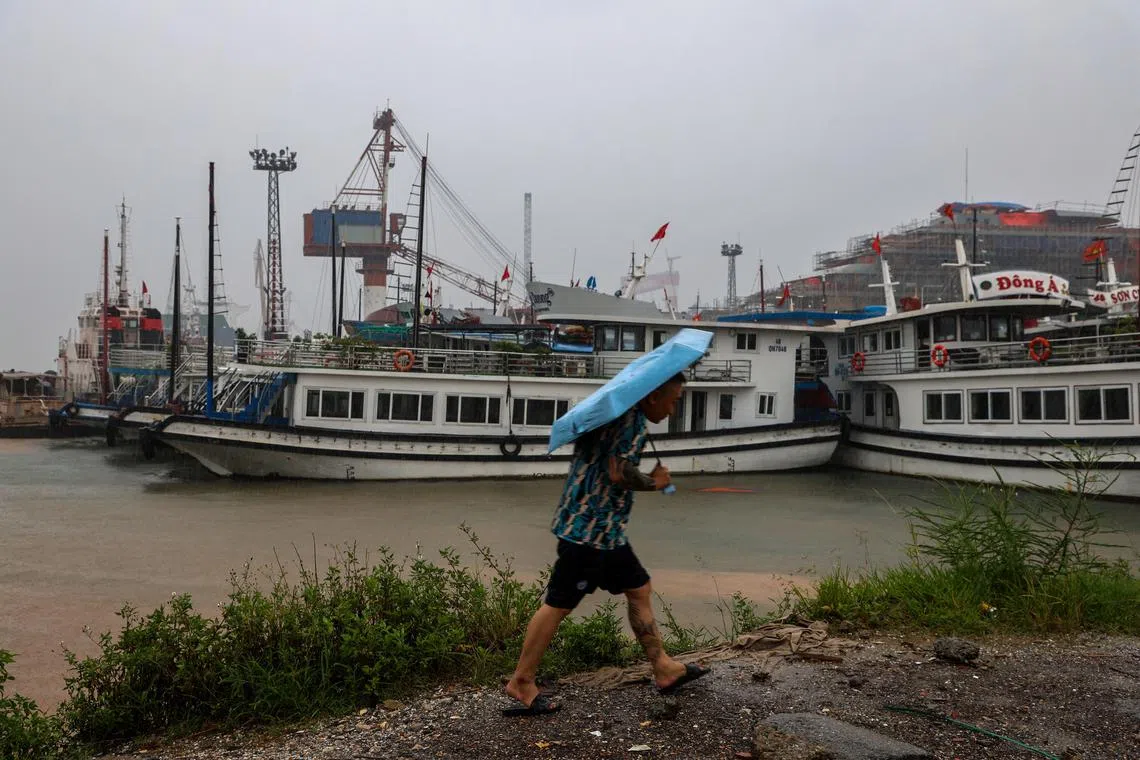Tropical storm Wipha makes landfall in Vietnam; heavy rain persists in Philippines
Sign up now: Get ST's newsletters delivered to your inbox

A man walking past docked tourist boats as Typhoon Wipha approaches, at Halong Bay, Quang Ninh province, on July 21.
PHOTO: REUTERS
Follow topic:
HANOI – Tropical storm Wipha weakened after making landfall in northern Vietnam on July 22, with the authorities on alert due to heavy rain that could cause flooding and mudslides, as the Philippines struggled with monsoon downpours that began last week.
Wipha hit the northern provinces of Ninh Binh and Thanh Hoa with wind speeds of up to 74kmh, slowing from around 100kmh on its approach, the national weather forecasting agency said.
With a long coastline facing the South China Sea, Vietnam is prone to typhoons that are often deadly, and Wipha is the first major storm to hit in 2025.
Heavy rain of up to 50cm were forecast to continue until early on July 23, and the authorities warned people to watch out for landslides in mountainous areas and flooding in urban areas.
Around 350,000 soldiers were put on standby.
Vietnam’s Prime Minister Pham Minh Chinh has put coastal provinces on emergency footing
“I have learnt from last year’s mistakes, when we underestimated Yagi,” Mr Ngo Van Thuong, a 40-year-old warehouse manager in Ha Long city, told Reuters as the storm neared.
“Doorways and roofs are places that need more attention, and, since yesterday, I have also put sandbags on top of the roof,” he said.
A fishing boat in Quang Ninh province capsized early on July 22, but all nine of the fishermen on board were saved, the Nguoi Lao Dong newspaper reported.
Airlines have cancelled and rescheduled dozens of flights, and some airport, port and train services have been suspended.
Photos on state media showed empty streets in the capital Hanoi, where many workplaces were closed on July 22, including the US embassy.
“We haven’t forgotten about Yagi and have taken extra measures to cope with Wipha,” said a resident of Cat Ba Island in Haiphong.
Floods, closures in the Philippines
In the Philippines, Wipha has intensified already torrential monsoon rain, triggering knee- to waist-deep flooding
Thousands of families remain in evacuation centres as relentless rain, which swept through the country’s north last week, continue to batter the country.
Philippine President Ferdinand Marcos Jr, currently on an official visit to the US, said government agencies have been mobilised to provide assistance.
“Relief goods are ready and are being delivered to affected areas, along with medical teams,” he said in a recorded message. “We’re ensuring transport, electricity and water supplies are stable for those affected.”
On July 20, Wipha, then at full typhoon strength, barrelled across Hong Kong
As the storm passed Hong Kong, more than 110mm of rain fell within three hours and maximum wind gusts exceeded 167kmh at some points, prompting the authorities to issue their highest storm warning.
Over in Thailand, two Chinese citizens were killed amid strong gusts and heavy rainfall on July 20, China’s state-run news agency Xinhua reported on July 22.
One person was killed by a tree blown down by strong winds on Coral Island in Phuket province and another was swept away and drowned while swimming in the sea in the province of Krabi, Xinhua reported, citing a Chinese consular office stationed in Phuket. REUTERS

